28 September 2023
All you need to know about food and drinks in Iceland
When visiting Iceland, you will discover its own unique cuisine. Not only do we have hot springs, northern lights, glaciers and other incredible natural features, we also have some of the world's strangest traditional food.
That is just the tip of the iceberg. There is so much interesting about our food and drinking culture.
Now you can find just about every kind of food or drink in Iceland. This has however not always been the case. The country was not always as international and an active member in the global society as it is today.
Due to its remote location, in the middle of the Atlantic Ocean, we have developed our own special food and drink culture. Throughout the centuries Icelanders have had to adopt special methods to grow and preserve food. This survival instinct has not changed; we are still improvising and making new ways to improve productivity. Adding new and combining old in our cuisine.
As a result, we have a unique food and drinking culture worth exploring.
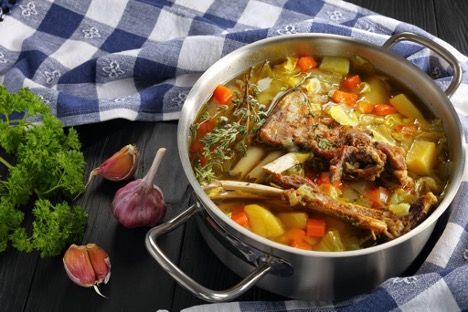
What makes Icelandic cuisine special?
Iceland is known worldwide for its untouched and beautiful nature. It is in fact one of the cleanest and unpolluted places in the world. That's why locally grown food is at the highest standard. We proudly claim to have the best air, best water, and the best food in the world.
As the name suggests, Iceland is not actually ideal for growing food. The long winter with extreme weather and lack of flatland make agriculture rather difficult in most parts of the island. On top of that there are volcanic eruptions and earthquakes on a regular basis.
Local Food
Despite these tremendous obstacles Icelanders are for many parts self-sufficient in their food production. We have learned to overcome challenges by utilizing technology and use nature to our advantage better transportations in recent years has also been hugely beneficial. Improving our food selection by importations of various products. Improving diet with more diversity in food selection.
As a result, today you can find food here, both local grown food and imported of all sorts. Including various meat products, fruits, vegetables, and fish of course.
What to eat in Iceland?
For many years the most typical dinner in Iceland was lamb or fish, usually haddock, and potatoes. Now times have changed, with more options available.
There are, however, some things that never change. A typical Sunday roast is for most still a leg of lamb. Served with potatoes, canned green peas, pickled red cabbage and gravy.
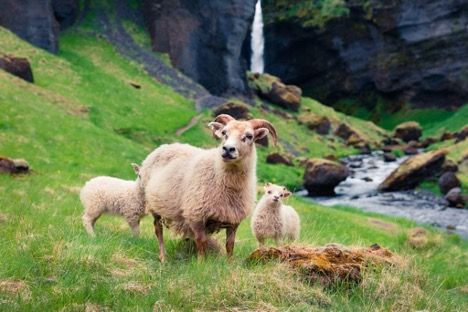
Land of Lamb
Sheep´s have lived here as long as people have. They are highly integrated into Icelandic culture and therefore, understandably a big part of our cuisine.
Lamb is both considered a fancy food and just regular everyday food. It just depends on what part of the lamb you are eating and how it's served.
For example. If you get invaded for a home cooked meal, you will most likely be served a leg of lamb. It is the most popular roast in Iceland along with a rack of lamb. If you go out for fine dining a lamb prime will most likely be on the menu as one of the main meat options.
Then there is all the other part of the lamb left. The unfancy parts. We eat them too.
In fact, there is almost no part of the lamb that we do not eat. Some are considered traditional food and are more seasonal than others.
Our Lamb Soup
The most popular lamb dish is by far the Icelandic lamb soup. It's extremely popular and we highly recommend it. It is a common dish at both homes and restaurants. Especially where there are many being served at once.
This traditional dish mostly consists of fatty bits of lamb meat and root vegetables, such as cabbage, carrots, beets, and potatoes. It is basically Iceland in a bowl.
Fresh Fish
Fish is a very popular food in Iceland. Being a fishing nation, we get fresh fish straight from the docks and to our plate. Everyone who visits should try Icelandic fish. It is one of our best food products.
Fish is however not just fish. There are so many kinds of fish available and even more ways to cook it. Here are some popular fish dices. All worth trying when in Iceland.
One of the most iconic dishes is a creamy fish stew (Plokkfiskur). Served with rye bread and butter.
We also like to pan fried fish. Mainly cod or salmon which are a popular “fish of the day” at restaurants. Another popular dish at restaurants is fish and chips.
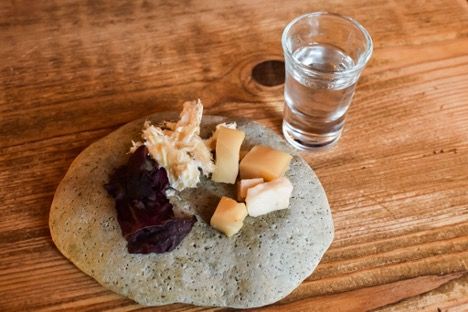
What is grown in Iceland?
An island sitting on the edge of the arctic circle is perhaps not suitable for growing fruits and vegetables. However, that is not entirely true. There are numerous fruits and vegetables grown here. There are two main reasons which make this possible.
First is the Gulf stream, a warm ocean current in the Atlantic Ocean, which makes the climate here milder. Therefore, it is possible to grow most root vegetables.
Geothermal Fruits
The other is the use of geothermal energy. The energy is used to heat up greenhouses where various fruits and vegetables are grown. There are surprisingly many fruits grown in Iceland. Such as tomatoes, peppers, cucumbers, and others that would not be possible to grow in a natural environment.
Therefore, finding locally grown fruits and vegetables at the highest quality is easily found.
Traditional food
Traditional food is part of this heritage. It is the food that was typical in Iceland before modern times. It might not be to everyone's liking but we highly recommend all travelers to try it. It is quite a unique experience.
For centuries Iceland's main food source came from only one animal, the sheep. They arrived in the year 874 with the first settlers and have been roaming free ever since.
The survival was based around the sheep and utilizing it in every way possible. There is nothing left when we´re done with it. We even eat ram testicles and the sheep's head, including eyes and ears.
Sheeps also kept the nation warm by providing wool for clothes. Hence the “lopapeysa” was created. The milk from the sheep was also used for dairy products. Such as butter, cheese and “skyr.”
Over the centuries this luckily changed and our diet improved with better transportation to the island, allowing new products and technology to be imported.

What is Þorramatur?
There are several dishes which are traditional Icelandic food. Some are quite strange and not appealing to most. But it all depends on taste. When we talk about traditional food, we are usually referring to a type of food called “Þorramatur”.
Þorramatur is meat which has been processed in the same way it was done before modern times. This usually means that the food has been made sour. For example, sour haggis, lamb fat, ram testicles, whale blubber and other food sources available in Iceland. Including burned sheep heads and sheep heads jelly.
Fermented shark
The most famous Þorramatur is probably the fermented shark. That is a Greenland shark served in small bits. It has an incredibly strong smell and taste. The shark is usually served with a strong alcohol snap called Brennivín, to counter the strong taste of the shark.
This food is mostly eaten during a time called “Þorri” which starts in mid-January and ends in mid-February. There is a tradition called “Þorrablót” where people of the communities gather for a feast where this traditional food is served.
Whale meat
Whale meat is probably the most excotic foods in Iceland. Most locals do not eat whale meat but it is possible to buy minke whale meat at supermarkets and in restaurants. In fact most of the of meat is consumed by tourists.
Puffins
Puffins have become a symbol of tourism in Iceland. People from all over the world travel here to see these funny looking sea birds. What many may not know is that puffins are also food. Usually smoked and served with butter, puffins are a popular dish in some parts of Iceland.
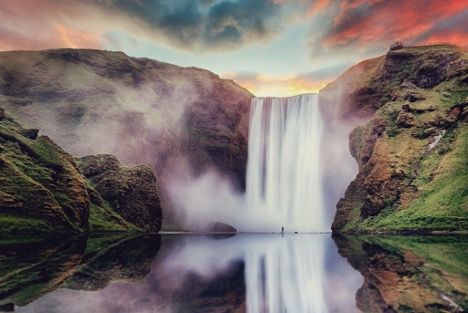
Local delicacy
There are other traditional foods, which can be found all around the year and are much more popular. These are more of a local delicacy. For example smoked lamb and dried fish.
We also have a world famous langoustine soup. Travelers come from all over the world to have this creamy orange lobster soup.
Smoked food
There is a rich tradition for smoked food in Iceland. Mainly lamb and freshwater fishes are smoked. You can find smoked fish, such as smoked salmon or trout at most restaurants and supermarkets.
Christmas Dinner
The smoked lamb is also popular. It is for example the most popular Christmas dinner. Over 70% of Icelanders eat smoked lamb on December 25th.
But smoked lamb is not only served at Christmas. It is also a popular topping, especially on flatbread.
Candy
We are a candy loving nation. Many of our most popular sweets are made locally and have their own unique taste and texture.
Salty Liquorice
Our most iconic candy duo is chocolate and liquorice. Both separate and together. Many foreigners and Icelanders agree that both the chocolate and liquorice taste different here than what they are used to elsewhere. The liquorice is saltier and tastes like salt-liquorice and the chocolate sweeter.
Chocolate lava
One of the most popular candies is a bar chocolate called “Hraun”. The name means lava and is because the crunchy bites resemble lava rocks.
Another popular candy is “Djúpur,” which is liquorice covered in chocolate and a M&M-like hard shell. There is also a similar version without the hard shell.
Luckily travelers should have no problem identifying Icelandic candy in store. It is usually well labeled in Icelandic.
The Prince of the roads
But we do not just love our own candy. For many years the Polish chocolate bar “Prins Polo” was the most popular candy bar in the country.
Having a Prince and Coke was the standard go to candy for many, especially when traveling. It is still rather popular and is found at any gas station and other places where you can buy candy. If you want to travel like the locals, we recommend trying it.
Spirits
Due to this endless supply of clean water, Iceland is a great place for producing drinks. For that reason, there are all sorts of local beverages available.
For example, spirits such as vodka, gin and whiskey. We also have our own national spirit called Brennivín. It is also known under the nickname Black Death.
Brennivín is best served ice cold and is often associated with the fermented shark. Its unique flavor helps to tone down the strong taste of the fermented shark.
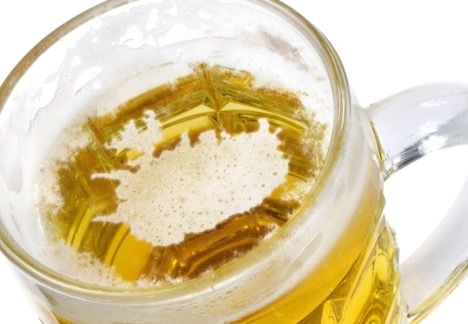
Beer
Believe it or not, but beer was illegal in Iceland until the year 1989. Upon that time only wine and spirits were allowed. Despite that insane fact, Icelanders have caught up quickly. Today there are hundreds of types of beer produced in Iceland.
Although we have not had the privilege of legal beer for a long time, there is a rather interesting beer culture.
In recent years microbreweries have entered the market with great success. Localized micro-breweries can be found in most parts of Iceland. Producing all types of beer. Many specializing in types like IPA, stout, and seasonal beers.
Seasonal beers
We love seasonal beers. They are a huge part of our drinking culture. The beer seasons are Christmas, Easter, Summer and Þorri. Both big producers and smaller micro-breweries are fully involved in this seasonal beer production. The opening of the Christmas beer is, for example, celebrated every year on a day called J-day. It is named after the Danish Christmas beer “julebryg” from Tuborg. Icelanders often buy many different types of seasonal beers and have a testing party.
Soft drinks
It is also worth mentioning that most big brand sodas, such as Coke and Pepsi are produced domestically and contain Icelandic water. Travelers may also want to try some of our own soft drinks. The most popular one being an orange soda called “Appelsín.”
Drinking culture
Reykjavik is a great city to party. There are many bars and clubs in the downtown area. On weekends the clubs are open until late in the night. Wheel of fortune is popular at bars where you pay for a spin. In return you can win beers or shoots.
Alcoholic beverages are not sold at supermarkets. Only in liquor stores. It is possible to find beer in supermarkets, but it is non-alcoholic.
Drinking age
The drinking age is 20 years of age. If you want to purchase alcohol in a bar, restaurant or in a liquor store, please bring a valid ID. There is a high chance you will be asked for it. If you are unable to prove that you are above legal drinking age, you will have to leave empty handed.
Happy hour
It is common for bars and restaurants to have happy hours, with drinks on special discount prices.
Happy hours are usually two to three hours. Usually starting from around 15:00 and ending at 19:00. The offers are mostly discounts on certain types of drinks. Such as beer, wine, and selected cocktails.

Where to buy food in Iceland
Travelers should be able to find most products they are familiar with in grocery stores in Iceland. Shopping in Iceland is not very different from shopping in other European or American stores.
There are, however, some local delicacies you can find here that are not in other parts of the world. Such as Skyr and other authentic Icelandic products.
If you are traveling on a budget, we recommend going to the supermarket to buy food. It is much cheaper than eating in restaurants or buying food at small convenient stores.
Discount supermarkets in Iceland are easily found. Many are located close to highways and the city center. The biggest supermarket chains are Krónan, Bónus and Nettó.
Fine dining
Over the past years, the restaurant scene in Iceland has literally exploded. The growing popularity of Iceland as a tourist destination has given birth to numbers and a variety of new restaurants in the country.
Eating out
Travelers should have no problem finding a restaurant to their liking. Whether they are looking for local delicacies or something more international, casual, or fine dining. These options and more are now available all over the island.
Fast Food
Iceland is among the few places in the world where you will not find a McDonalds restaurant. The last one closed in 2009. You will also not find Burger King. In fact, there are no worldwide hamburger brands in the country.
Despite that, fast food is quite common and easily found. The most popular fast-food chains in Iceland are KFC, Dominos and Subway.
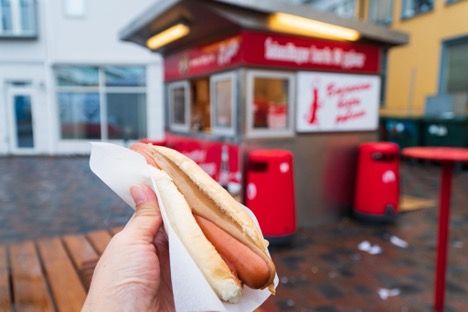
Hot Dog
The Icelandic hot dog, called “pylsa” is by far the most popular fast food in Iceland. It is considered by many to be our national dish. The “pylsa” or “pulsa” depending on how you ask, is a hot dog served in a hot dog bun. There are typically five toppings served with authentic “pylsa” and most Icelanders want all of them.
A pylsa with everything has raw onion, deep fried onion, ketchup, mustard, and remoulade sauce. But it is absolutely not necessary to get all of them. Everyone is free to choose their set of toppings from these five types.
Price of Food
The food price is very consistent. For example it is the same in Reykjavik and in other parts of Iceland within the same supermarket chain. It is similar at restaurants. It is of course possible to find more expensive or cheaper options in Reykjavik, due to the numbers of different kinds of restaurants in the capital area. However, on average, the price for eating out is very similar in Iceland. The same goes for drinks. The beer price is for example the same in every liquor store and similar at bars around Iceland. Prices are always listed in Icelandic Krona. You might be able to pay in different currencies such as Euro, US dollar or British pound, but do not rely on it.
Payment
Cash is acceptable but is not widely used in Iceland. Travelers can rely on their payment cards and should have no problems using their debit or credit cards. Brands such as MasterCard, American Express, Visa, Discovery, and Maestro are accepted almost everywhere.
English
English is the language of the tourist industry in Iceland. Travelers can count on using English everywhere they need service. In fact, it is even more likely that the staff will speak English than Icelandic in most places. It is common for restaurants to have an English side of the menu as well as Icelandic.

Favorite food and drinks
One of the best ways to explore culture is by trying the local cuisine. Here is a list of our most iconic and popular food and drinks. These Icelandic dishes are in our opinion, a must try for every traveler visiting:
- The Icelandic lamb soup (Kjötsúpa)
- Smoked lamb (Hangikjöt)
- Icelandic hot dog (Pylsa)
- Twisted dough (Kleina)
- Fish casserole (Plokkfiskur)
- Leg of lamb (Lambalæri)
- Arctic Char (Bleikja)
- Atlantic Cod (Þorskur)
- Skyr
- Langoustine soup (Humarsúpa)
- Icelandic snaps (Brennivín)
- Seasonal beers (Bjór)
Useful Travel Tips.
There are always pros and cons to every decision made on vacation. That's why we want to sum up and go over some useful travel tips about the food culture in Iceland.
- Alcoholic drinks are only sold in liquor stores. The beer in supermarkets have little or no alcohol in them.
- Liquor stores have limited opening hours and are all closed on Sunday. If you want to buy drinks make sure it is in time.
- For fine dining in Reykjavik it is best to reserve a table in advance.
- Iceland is known for good fish and lamb. If you want to try quality Icelandic food, fish and lamb is usually a safe bet.
- Local restaurants often serve local delicacies, not found anywhere else. Such as locally grown vegetables, meat or wild fish caught.
- Food prices in Iceland are among the highest in the world. Travelers can cut down expenses by shopping at supermarkets. But bear in mind the prices might be higher than most are used to.
- Buying at small shops and gas stations is very expensive. Preparing food and taking with you on trips, such as long road trips, hiking and other activities will save you a lot of money.
- It is not custom to leave a tip at restaurants. There is nothing against it, but it is definitely not mandatory.
We could go further into Icelandic cuisine. There is so much more to mention but we believe we have gone over the most important facts. At least this should show that Iceland certainly has much to offer when it comes to food and drinks.
Now you should be ready to explore all that Icelandic cuisine has to offer. Bon appetit! Or as we say in Iceland. Verði þér að góðu!
Feel free to read more about Icelandic Culture in Our Stories.